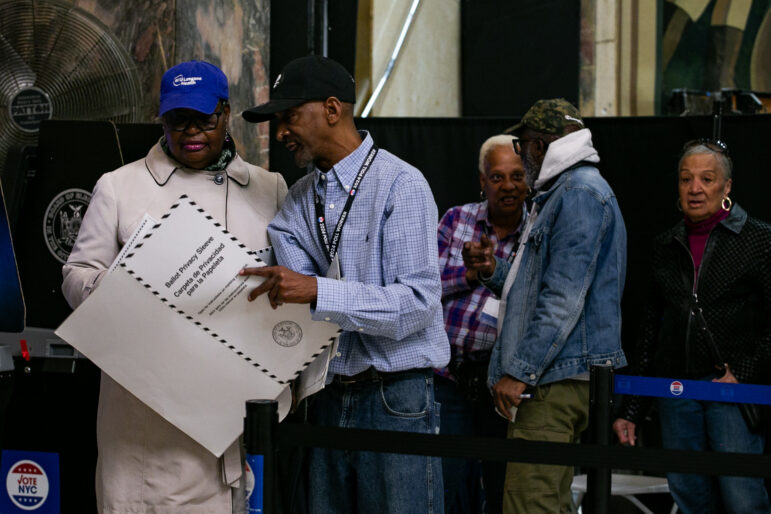
DeShaun Craddock
Life expectancy in Brownsville, Brooklyn (above) is about 11 years shorter than in Tribeca or Murray Hill.
A cascade of crises is forcing America to confront the racism of its past and present—from overt acts of hate to subtler injustices that shape our society. Over 16 weeks, City Limits and Enterprise Community Partners will feature prominent New Yorkers’ views on how race and housing policy intersect to create a legacy each of us must confront, and the way forward we should take together. These are not necessarily views we endorse. But they are views we fully believe are important to share with each other. Here is the 11th post in our series. Read the rest here.
* * *
In June 2000, as President Bill Clinton congratulated an international team of scientists on the successful mapping of the human genome, he predicted that this important work would have “a real impact on all our lives” and that it would “revolutionize the diagnosis, prevention, and treatment of most, if not all, human diseases.” Today, when almost every conference or paper discussing the social determinants of health draws comparisons between the relative influence of one’s genetic code and ZIP code, the same could be said for the promise of addressing disparities in housing affordability, health, and neighborhood quality.
However, there is an important difference. President Clinton also observed that the human genome project reinforced our common humanity, noting that “in genetic terms, all human beings, regardless of race, are more than 99.9 percent the same.” But the latest research on the impact of housing on health shows that the disparities remain enormous. In a 2015 article describing a study of life expectancy by neighborhood, The New York Times described patterns in New York City, where life expectancy averages 81 years, this way:
In Tribeca, Murray Hill and the Upper East Side, the average resident lives until 85 — on par with places in the world with the highest life expectancy like Japan and Hong Kong. In Brownsville, Brooklyn, about 10 miles away, life expectancy was 74, closer to that in Brazil. Brownsville has the largest concentration of public housing of any neighborhood in the city. Residents there die from most major diseases at much higher rates than the city average.
Where you live, as it turns out, can impact health through a variety of pathways including the physical condition of the home (and its design), the attributes of the surrounding neighborhood, and its affordability. These pathways are interrelated and can work together to either promote or undermine health. For instance, housing affordability can make it hard for a family to stay in one home, a key predictor of educational outcomes for children. But it can also make it hard for a family to leave a home afflicted with mold or cockroaches, which can exacerbate a child’s asthma; or that has poor access to healthcare services, which can help them keep that child’s asthma under control. It can also mean making tradeoffs between healthy behaviors (e.g., to invest limited resources in keeping a home warm and dry or in obtaining healthy foods that may be hard to come by in many neighborhoods). By the same token, affordable housing means residents can devote resources to health, instead of choosing between paying rent and paying the doctor.
For most Americans, the concept of home is synonymous with a place that provides security and shelter. But homes that are poorly constructed or maintained; are unaffordable to rent, buy, or maintain; or are located in neighborhoods that lack basic amenities or services will significantly worsen the health and safety of residents. In many communities, disparities in health outcomes like asthma or lead poisoning are exacerbated by disparities in housing quality. Homes that are full of cockroaches and mold and other asthma triggers can make it nearly impossible for a parent to help control a child’s asthma, even if they’re doing everything else correctly. In communities where rates of asthma or childhood lead poisoning are high, these disparities place additional strain on already stressed health, educational, and social service systems. And these are costly problems for our society. The economic burden of housing-related illness and injury in the U.S. is estimated at $53 billion every year, a cost that all of us pay.
The disparities in U.S. housing quality are best characterized by data from the American Housing Survey (AHS), a large representative longitudinal sample of housing conditions at both the national and the city levels. The latest AHS data from 2013 indicated that 9.2 percent of non-Latino Black homes and 7.2 percent of Latino homes have severe or moderate physical problems, compared with 3.2 percent of non-Latino White homes. This translates to roughly 3.1 million non-Latino Black, 3.2 million Latino, and 6.6 million White people who live in homes that are moderately or severely inadequate. Clearly, the prevalence of poor housing conditions is higher among racial and ethnic minorities, and the absolute numbers suggest that the total number of White households at risk is also substantial.
Although the racial and ethnic disparities in housing with both severe and moderate physical problems are large, one case, childhood lead poisoning, provides evidence that such disparities can be reduced. Most other health- and housing-related disparities have trended together for decades, but blood lead levels have improved by 90 percent since the late 1970s.
These two contrasting outcomes (improved and persistent disparities) are examples of the evidence that health-related housing disparities are pronounced but that effective interventions to reduce them exist and can achieve great success if implemented.
However, the Flint water crisis reminds us that investment in these interventions must be not only widespread but sustained; Flint demonstrates that much more remains to be done to finally conquer lead poisoning, an entirely preventable disease. And, of course, some housing-related health hazards are not necessarily related to socioeconomic and racial disparities. For example, the prevalence of radon hazards in housing appears to be associated with geological factors more than with socioeconomic factors, although remediation resources are unlikely to be equitably distributed.
Disparities are not limited to exposure or lack of resources to reduce exposure but to actual health outcomes up to and including death. Numerous studies have documented adverse health consequences associated with living in highly segregated neighborhoods. Analysis using NHANES data showed significant variation in body mass index by neighborhood and ethnicity.
Inequalities in mortality between residents of poor and very poor (i.e., public housing) neighborhoods in New York City showed clear disparities in age-standardized all-cause mortality rates with preventable diseases, such as malignancies, diabetes, and chronic lung disease, contributing to the disparity. Repeated hospitalizations for childhood asthma are correlated with children residing in the census tracts with the highest proportion of crowded housing conditions, largest number of racial minorities, and highest neighborhood-level poverty. Using four nationally representative surveys, Reid et al. examined housing instability and found that worsening economic standing was associated with poorer healthcare access, being uninsured, postponing needed care, and higher hospitalization rates. In a large cohort of more than 12,000 New York City households, asthma was most prevalent in Puerto Rican households, followed by other Latino and Black households, with exposure to deteriorated housing conditions and low social cohesion in the neighborhood significantly elevating the odds of asthma.
Indicators of housing deterioration in that study included maintenance problems such as toilet and heating breakdowns, need for additional heat, the presence of rats or mice, broken plaster, and leaks, cracks, or holes in floors, walls, or ceilings. The study also used measures of crowding, and the neighborhood indicators included boarded-up buildings nearby. This study not only found increased odds of asthma but also demonstrated that multiple housing deficiencies are found together, thus magnifying the asthma risk. Interestingly, the analysis found that these housing and neighborhood factors were independent of the influence of socioeconomic status (but not of race and ethnicity). These findings are consistent with those of another large study showing that housing is an important mediator of the pathway from social and physical conditions to pollutants to health outcomes.
Disparities in asthma morbidity and mortality have been well characterized and have been associated with housing disparities and segregation. In 2014, current asthma prevalence was higher in children (8.6 percent) than in adults (7.4 percent), in African Americans (9.9 percent) than in Whites (7.6 percent), in those of Puerto Rican descent (16.5 percent) than in those of Mexican descent (5.7 percent), and in those below the federal poverty level (10.4 percent) than in those at or above the federal poverty level (6.3 percent –7.6 percent).16 Analysis of NHANES data also showed statistically significant increased odds of sensitivity of Black children than White children to cockroaches, house dust mites, and certain fungi (mold), all of which are important factors in housing-associated asthma.
The fact is that much more needs to be done to make homes and neighborhoods safe, healthy, and affordable, especially among low-income families. Unsafe and unhealthy housing or neighborhoods conditions can cause significant illnesses, injuries, and deaths; and while many are preventable, people may be unaware of hazards that exist in their homes. Some people simply need information about the hazards, but others need help making their home environment safer. Fortunately, we have a strong evidence base of what works to create healthier home environments, improve health, and provide real savings to the healthcare and other sectors.
If housing segregation can be reduced, one would expect to see improved health outcomes. In the Moving to Opportunity study, 4,608 low-income families residing in central-city public housing in high-poverty neighborhoods in five cities were randomly assigned to one of three groups: (1) the experimental group, which was offered Section 8 (a federal subsidized housing program) vouchers that could be used only in a low-poverty, mixed-income neighborhood; (2) the comparison group, which was offered geographically unrestricted Section 8 housing vouchers and tended to reside in more segregated housing; and (3) the control group, which did not receive vouchers but remained eligible for public housing.
Although health was not the primary focus of the Moving to Opportunity study, Orr et al. did find better health among members of the experimental group, including an 11 percent reduction in adult obesity in the experimental group and improved perceived safety and improved mental health in girls, including reductions in psychological distress, depression, and generalized anxiety disorder and lower rates of smoking and marijuana use. Data from the Yonkers Scattered-Site Public Housing Program have corroborated the evidence linking improved mental health outcomes to housing mobility interventions and reduced housing segregation. Because low-income populations tend to move from house to house frequently, studies that examine health outcomes associated with housing mobility are especially important in building the evidence base of effective interventions, especially for disadvantaged populations.
Based on decades of research and demonstration projects across the nation, we have strong evidence that we can prevent many health impacts through housing regulation, inexpensive repairs, ongoing maintenance, and small behavior changes. We also know that these investments make sense and that each dollar invested to reduce asthma triggers at home provides a return on investment of $5.30–$14.00, while each dollar invested in lead paint hazard control results in a return of $17–$221. It’s also important to note that improving housing quality doesn’t just improve health; it also lifts up our communities through improvements in education, crime, and productivity, allowing individuals and families to thrive.
For the last year, the nation has followed the needless tragedy in Flint, Michigan, and in the midst of their outrage many have stopped to wonder whether such a thing could happen to their community, to their family. And for all too many communities, the answer will not only be that it could happen but that it is happening already.
This state of affairs is unacceptable to the nation. We could decide, as we did with the human genome mapping project, to set our sights on the common goal of eliminating illness and injury associated with poorer access to quality, affordable housing, and investing in the solutions accordingly. Reducing housing-related health disparities requires increased investment in research that examines sources and pathways of exposure in the home and community environment; practical and proven interventions that prevent and reduce the probability of illness and injury; a unified healthy housing research agenda; longitudinal integrated representative housing and health population-based surveys; and, perhaps most important, broad implementation of healthy housing concepts into housing design, construction, maintenance, finance, and rehabilitation systems. We could do it. We could decide to put systems and policies in place that protect and promote the health of Americans today and for generations to come. Such investments will save money, create jobs, and rebuild our housing infrastructure.
A broad coalition of partners is urging such action on lead poisoning. The idea is simple yet comprehensive: Find lead hazards, eliminate them, and build the political will to create key public investments and policies to do so. And then take that strategy to reduce exposure to other environmental hazards in the home.
Imagine this: The major story of 2017, in the wake of Flint, is that we decided as a nation to celebrate our differences, not underscore our disparities, by coming together to mobilize the solutions we already have to end housing disparities that undermine health, education, and quality of life and to bind up the nation’s wounds.










2 thoughts on “Building Justice: Genetic Code, ZIP Code and Housing Code All Affect Health and Equality”
Pingback: Community Developments: Health and Housing Conditions, Fair Housing Funds – Right Now Help Services
Pingback: News - October 2016 - East Harlem Preservation